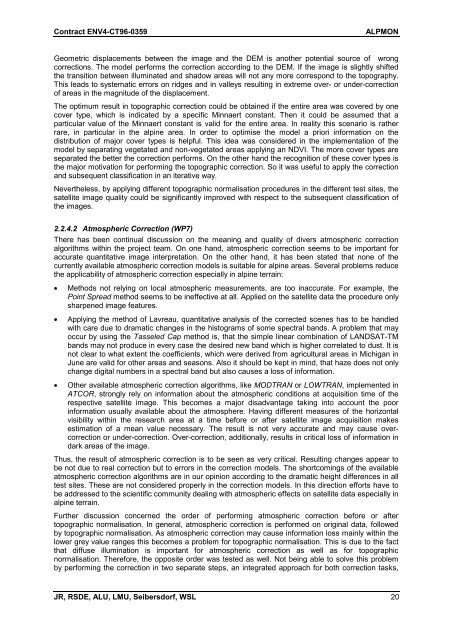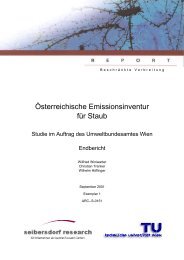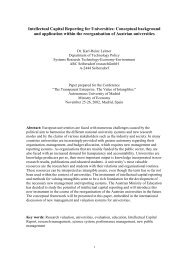ALPMON FINAL REPORT - ARC systems research
ALPMON FINAL REPORT - ARC systems research
ALPMON FINAL REPORT - ARC systems research
Create successful ePaper yourself
Turn your PDF publications into a flip-book with our unique Google optimized e-Paper software.
Contract ENV4-CT96-0359 <strong>ALPMON</strong><br />
Geometric displacements between the image and the DEM is another potential source of wrong<br />
corrections. The model performs the correction according to the DEM. If the image is slightly shifted<br />
the transition between illuminated and shadow areas will not any more correspond to the topography.<br />
This leads to systematic errors on ridges and in valleys resulting in extreme over- or under-correction<br />
of areas in the magnitude of the displacement.<br />
The optimum result in topographic correction could be obtained if the entire area was covered by one<br />
cover type, which is indicated by a specific Minnaert constant. Then it could be assumed that a<br />
particular value of the Minnaert constant is valid for the entire area. In reality this scenario is rather<br />
rare, in particular in the alpine area. In order to optimise the model a priori information on the<br />
distribution of major cover types is helpful. This idea was considered in the implementation of the<br />
model by separating vegetated and non-vegetated areas applying an NDVI. The more cover types are<br />
separated the better the correction performs. On the other hand the recognition of these cover types is<br />
the major motivation for performing the topographic correction. So it was useful to apply the correction<br />
and subsequent classification in an iterative way.<br />
Nevertheless, by applying different topographic normalisation procedures in the different test sites, the<br />
satellite image quality could be significantly improved with respect to the subsequent classification of<br />
the images.<br />
2.2.4.2 Atmospheric Correction (WP7)<br />
There has been continual discussion on the meaning and quality of divers atmospheric correction<br />
algorithms within the project team. On one hand, atmospheric correction seems to be important for<br />
accurate quantitative image interpretation. On the other hand, it has been stated that none of the<br />
currently available atmospheric correction models is suitable for alpine areas. Several problems reduce<br />
the applicability of atmospheric correction especially in alpine terrain:<br />
� Methods not relying on local atmospheric measurements, are too inaccurate. For example, the<br />
Point Spread method seems to be ineffective at all. Applied on the satellite data the procedure only<br />
sharpened image features.<br />
� Applying the method of Lavreau, quantitative analysis of the corrected scenes has to be handled<br />
with care due to dramatic changes in the histograms of some spectral bands. A problem that may<br />
occur by using the Tasseled Cap method is, that the simple linear combination of LANDSAT-TM<br />
bands may not produce in every case the desired new band which is higher correlated to dust. It is<br />
not clear to what extent the coefficients, which were derived from agricultural areas in Michigan in<br />
June are valid for other areas and seasons. Also it should be kept in mind, that haze does not only<br />
change digital numbers in a spectral band but also causes a loss of information.<br />
� Other available atmospheric correction algorithms, like MODTRAN or LOWTRAN, implemented in<br />
ATCOR, strongly rely on information about the atmospheric conditions at acquisition time of the<br />
respective satellite image. This becomes a major disadvantage taking into account the poor<br />
information usually available about the atmosphere. Having different measures of the horizontal<br />
visibility within the <strong>research</strong> area at a time before or after satellite image acquisition makes<br />
estimation of a mean value necessary. The result is not very accurate and may cause overcorrection<br />
or under-correction. Over-correction, additionally, results in critical loss of information in<br />
dark areas of the image.<br />
Thus, the result of atmospheric correction is to be seen as very critical. Resulting changes appear to<br />
be not due to real correction but to errors in the correction models. The shortcomings of the available<br />
atmospheric correction algorithms are in our opinion according to the dramatic height differences in all<br />
test sites. These are not considered properly in the correction models. In this direction efforts have to<br />
be addressed to the scientific community dealing with atmospheric effects on satellite data especially in<br />
alpine terrain.<br />
Further discussion concerned the order of performing atmospheric correction before or after<br />
topographic normalisation. In general, atmospheric correction is performed on original data, followed<br />
by topographic normalisation. As atmospheric correction may cause information loss mainly within the<br />
lower grey value ranges this becomes a problem for topographic normalisation. This is due to the fact<br />
that diffuse illumination is important for atmospheric correction as well as for topographic<br />
normalisation. Therefore, the opposite order was tested as well. Not being able to solve this problem<br />
by performing the correction in two separate steps, an integrated approach for both correction tasks,<br />
JR, RSDE, ALU, LMU, Seibersdorf, WSL 20




